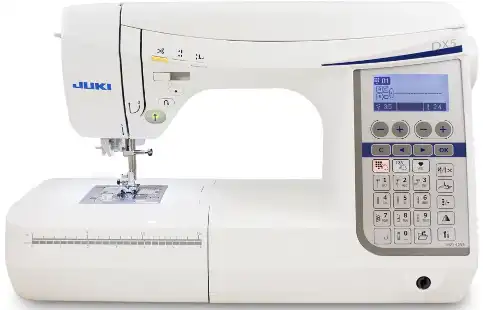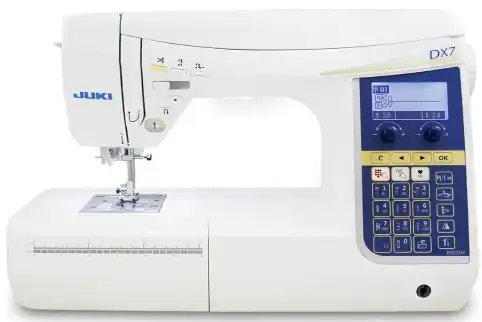The Ultimate Showdown: Juki DX5 vs DX7 Sewing Machines
The debate between Juki DX5 and DX7 often leaves sewers scratching their heads. Both sewing/quilting machines boast impressive specs and capabilities around the $1400USD price point. This comprehensive comparison of Juki DX5 vs DX7 aims to highlight the key differences and help you make an informed choice.

Covering all the vital specs and features, this post examines the top computerized machines from Juki. Understand how speed, stitch patterns, accessories, and sewing experience vary between the DX5 and DX7. Whether you are a beginner or an experienced sewer, learn which model truly suits your budget and sewing requirements.
Juki DX5 – Impressive Capabilities for All Sewers
With 185 built-in stitches and three fonts, the Juki DX5 offers extensive creative options for sewers. This computerized machine enables adjusting stitch length and width easily using buttons. The DX5 comes with 10 accessories, including handy presser feet for topstitching, zippers, and more.
The DX5 truly excels at delivering a flawless sewing experience. Its box feed mechanism facilitates neat stitches and smooth fabric feeding. The single needle hole lets you shift to perfectly aligned straight stitching. Create consistent buttonholes using the sensor system. Control stitching speed via the foot controller.
LED lighting in the needle area provides visibility when dealing with dark fabrics. Quiet and smooth operation allows you to sew for hours without fatigue. With great value for money, the feature-packed Juki DX5 is ideal for sewers of all skill levels, from beginners to experts. Its versatility accommodates every sewing or quilting project.
Read: Juki HZL-DX5 Sewing Machine: A Detailed Review
Juki DX7 – Upgraded Features for Advanced Sewing
The Juki HZL-DX7 takes sewing experience to the next level. With 287 built-in stitches and 4 fonts, it offers more creative possibilities than the DX5. This computerized machine enables adjusting stitch length and width via convenient knobs instead of buttons.
14 accessories come included with the DX7, providing a smooth sewing experience right out of the box. The extra presser feet handle specialty tasks like free-motion quilting. Like the DX5, the HZL-DX7 provides a box feed mechanism and single needle hole for fabric consistency.
Advanced sewers will appreciate the DX7’s automatic tension feature. Switch to a straight stitch easily using the front lever. The LED lights now illuminate the throat space in addition to the needle area. A handy table extension offers a larger working surface for big projects.
With superior lighting, more accessories, and enhanced controls, the feature-laden Juki DX7 satisfies sewers seeking an upgrade. However, the DX5 remains a great choice for budget buyers. Evaluate your needs to decide if the DX7’s upgrades justify the higher price tag.
Read: Juki HZL-DX7 Review: A Detailed Look At This Feature-Packed Sewing Machine
Juki DX5 vs DX7: Detailed Comparison
Choosing between the DX5 and DX7 requires examining the specifics. While the models share similarities, key differences impact your sewing experience. This comprehensive feature comparison will help you determine the best Juki for your needs.
Stitches and Fonts
- DX5: 185 built-in stitches, 3 fonts
- DX7: 287 built-in stitches, 4 fonts
The DX7 offers over 100 more stitches for creative projects. Both provide adequate options for clothing, crafts, and quilting.
Speed and Feed Mechanism
- Up to 1050 stitches per minute on both models
- Identical box feed mechanism for smooth fabric feeding
No difference in sewing speed or baseline fabric handling.
LED Lights
- DX5: Single light at needle
- DX7: Dual lights at needle and throat
The extra lighting makes TASKS like free motion quilting easier on the DX7.
Accessories
- DX5: 10 included accessories and feet
- DX7: 14 included accessories and feet
More specialty feet accommodate projects like applique and quilting on the DX7.
Key Feature Comparison
| Feature | Juki HZ-DX5 | Juki HZL-DX7 |
|---|---|---|
| Built-in Stitches | 185 | 287 |
| Fonts | 3 | 4 |
| LED Lights | 1 | 2 |
| Included Feet | 10 | 14 |
| Max Speed | 1050 spm | 1050 spm |
| Auto Tension | No | Yes |
| Table Extension | No | Yes |
The table summarizes the DX7’s advantage in stitches, fonts, lighting, and accessories. Both match in critical areas like max sewing speed.
The DX7 justifies its higher price with increased programming, functionality, and bonus accessories. However, the DX5 remains a high-performing computerized sewing machine at a lower investment. Analyze your sewing requirements and budget to determine the best choice.
Additional Factors Impacting Your Decision
Choosing between the Juki DX5 and DX7 involves more than just feature comparisons. Other vital factors impact which model best fits your needs.
Pricing and Budget
- DX5 – More affordable option around $1200
- DX7 – Slightly higher investment around $1400
If stretched budget is a concern, the DX5 provides tremendous value. The DX7 merits its higher price but may be out of reach for some buyers.
Ease of Use
- Identical box feed mechanisms for consistent fabric handling
- Similarly placed controls and displays
- Comparable threading and bobbin winding
Both models earn praise for simplicity of use from beginners to experts. The DX7’s added stitches and accessories provide more options without compromising ease of use.
Noise Level
- DX5 – Slightly louder noise from walking foot
- DX7 – Quieter and smoother operation
This could impact prolonged sewing sessions, where the DX7’s quieter sound gives it an edge.
User Reviews
- Consistent positive feedback on durability and performance
- Mixed experiences with included auto threaders
- Learning curve noted for bobbin winding by some users
Overall, both models satisfy most customers with their sewing capabilities, longevity, and value. Individual experiences with minor features vary.
Carefully weigh factors like budget, sewing volumes, and noise tolerance. For most sewers, the DX7’s upgrades merit the higher price. However, the DX5 remains a versatile, affordable option for budget-focused buyers seeking core Juki quality and performance.
The Ideal Choice – Juki DX7 for Most Sewers
After comparing the Juki DX5 and DX7 across multiple factors, the DX7 emerges as the best choice for most sewers. Here’s a summary of why:
- More built-in stitches and fonts – The DX7’s expanded programming provides creative possibilities for all types of sewing, crafting, and quilting projects.
- Superior lighting – Dual LED lights make tasks easier by illuminating both the needle area and throat space. This enhances visibility when dealing with dark or bulky fabrics.
- Bonus accessories included – The DX7 ships with 4 additional presser feet beyond the DX5’s offerings. Specialty feet accommodate techniques like applique and quilting.
- Automatic thread tension – This convenient feature takes guesswork out of setting tension for different stitch types and fabrics. It facilitates consistency.
- Table extension – The included expandable table offers extra working room for large or bulky projects like quilts. A handy upgrade over the DX5.
- Justified price difference – The DX7 costs around $200 more than the DX5. Given the upgrades, most sewers will find this price premium reasonable.
However, the DX5 remains a smart choice for sewers on a tight budget below $1200. It delivers core Juki quality and performance. The DX5 lacks some of the DX7’s convenient features, but provides tremendous value at its price point.
For sewists focused purely on dressmaking and garment construction, the DX5 should meet needs splendidly. But the DX7 is undoubtedly the wiser long-term investment for sewists desiring maximum versatility across sewing disciplines.
In conclusion, while both models are excellent, the DX7 gets the nod for most users based on features, accessories, lighting and value.
Parting Thoughts on the Juki DX5 and DX7
The Juki DX5 and DX7 represent the pinnacle of quality and performance in their class. With impressive capabilities and specifications, both sewing machines empower sewers to realize their creative visions. This comprehensive feature-by-feature comparison aimed to provide clarity regarding the differences.
For most sewists, the Juki HZL-DX7 deserves serious consideration for its smart upgrades. However, budget-focused buyers will appreciate the DX5’s balance of value and capabilities. Visit Juki to explore additional models like the DX 2000QVP. Share your experiences with the Juki HZL-DX5 or DX7 in the comments! Happy stitching on your Juki!


